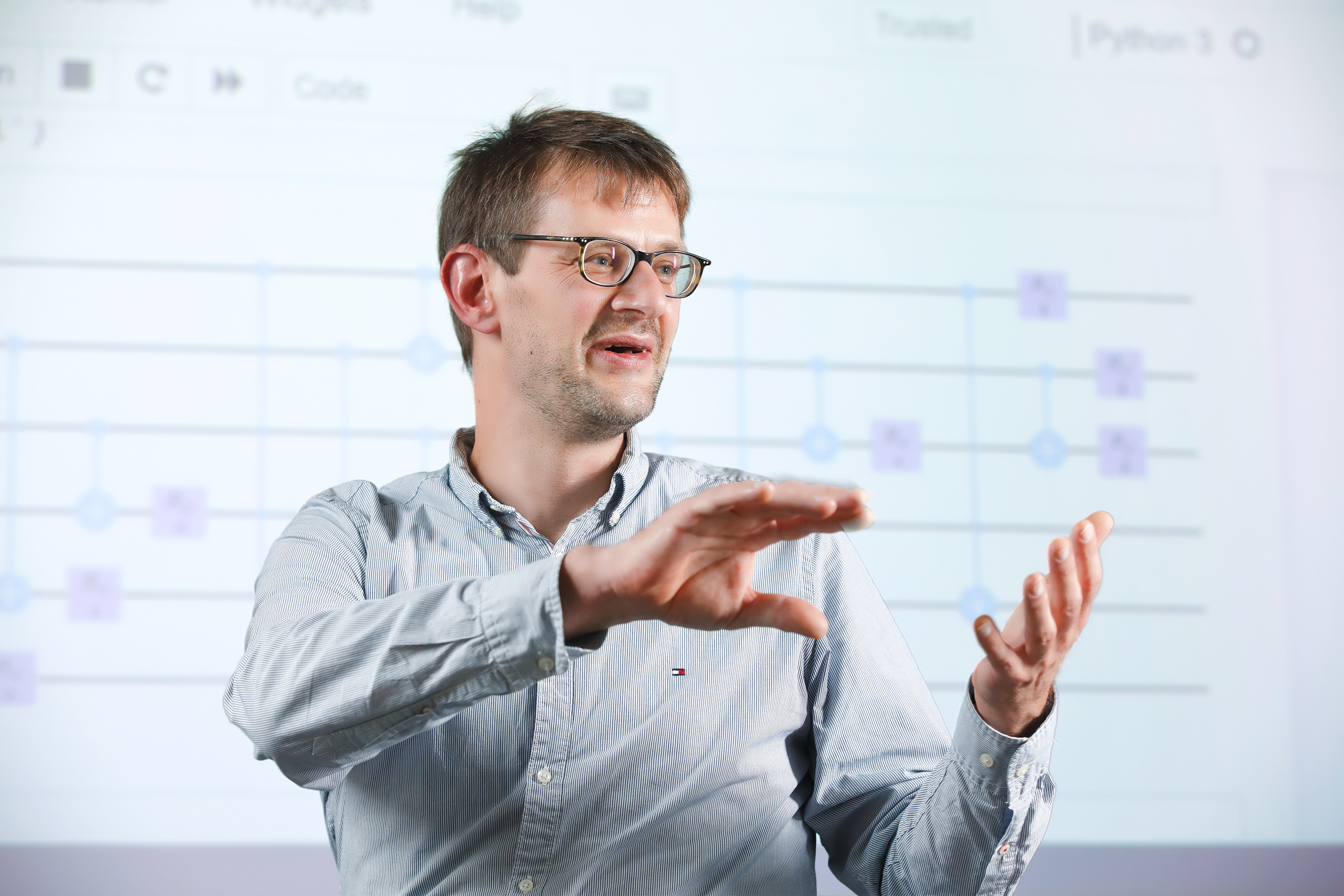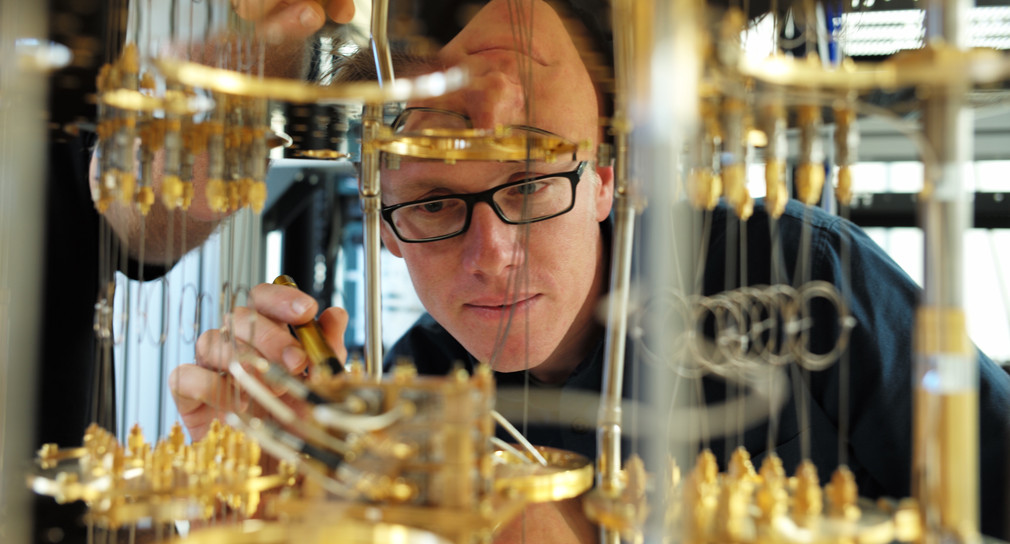In this interview, the project leaders at the two Fraunhofer Institutes, Dr. Thomas Wellens and Dr. Christian Tutschku, talk about the dynamic research field of quantum computing. In doing so, they look back on a first successful funding phase of the Competence Center by the Ministry of Economics, Labor and Tourism Baden-Württemberg and look ahead of what is to come.
In conversation about the Competence Center Quantum Computing Baden-Württemberg
The media often talk about breakthroughs in quantum computing. How do you experience the current research landscape?
Wellens — I have also noticed this hype and it really is a very interesting and promising field of research. But it is important not to promise too much. From my point of view, there is still a lot of basic research to be done before quantum computing can be put to use. One often reads that quantum computing will revolutionize all sorts of things — keyword Big Data —, but often it is not at all clear in which cases it will provide a real advantage. That has yet to be figured out.
Tutschku — Just as Thomas says, news that create false expectations are always difficult, especially in applicationoriented quantum computing. While there are breakthroughs all the time: The quantum volume is continuously increasing, for example, and new techniques like circuit knitting are getting us closer to real quantum advantage, one always has to manage expectations. Even though there has been an incredible amount of progress in both software and hardware development in recent years, we still cannot change the world with quantum computing today.


What stands in the way of true QuantumAdvantage?
Tutschku — We are in the so-called NISQ (Noisy Intermediate-Scale Quantum) era in quantum computing, which means the systems are error-prone and not yet available with great computing power. This makes it difficult to prove a true quantum advantage. So far, we can work with heuristics to show an advantage on the software side.
Wellens — In addition, we still have to find the algorithms that actually provide an advantage. There are algorithms, such as the Shor algorithm, for which a quantum advantage has been theoretically proven, however, only under the assumption that no computational errors occur, which is far from the state of the art. One challenge, therefore, is to find out whether we can already achieve a quantum advantage in applications in the near future, despite the error-prone hardware. At the same time, on the hardware side, the challenge is to reduce theerrors and get quantum error correction to work.
Tutschku — In this context, it is important to practice hardware-software co-design, in other words, to always think about both errors and scalability on the hardware side. In addition, the problem formulation must be rethought — from classical, deterministic thinking to probabilistic solution strategies that are thought ›quantum‹ from the start. One cannot simply apply quantum computing to existing problem formulations, but must adapt them accordingly.
What characterizes the Competence Center Quantum Computing Baden-Württemberg?
Tutschku — Quantum computing forms a very large ecosystem in which many small gears mesh together. Advancing this research is a task that no group can accomplish alone. It can only be done together. That is the basic idea behind the competence center: bringing all parties together from the beginning and working closely together to advance the research field. We gather scientists from a wide range of sectors, from basic research at universities to application-centered research groups at the Fraunhofer-Gesellschaft. In addition, there are companies as associated partners, and finally, behind everything, there is the state of Baden-Württemberg, which significantly supports the competence center and our projects. This is the only way to avoid being left behind in this dynamic research field.

How does collaboration work in an interdisciplinary research center such as the KQCBW?
Wellens — Collaboration is going well and exchanges are taking place beyond the project boundaries. The individual Fraunhofer institutes and universities are in some cases part of several projects, which results in synergies. Some research questions arise in different projects, such as error mitigation or optimization of the QAOA algorithm, which ultimately allows everyone to benefit from each other.
Tutschku — A special feature of the cooperation in the KQCBW is, above all, its spirit. The people in the competence center work together closely and with a special motivation. They accept the current state of the technology and improve it together. In the process, everyone works very openly and closely with each other. This is not to be taken granted, since people in research often keep a low profile before publications, and a competitive mentality prevails. In the competence center, there is a special trust in each other — people share ideas and talk openly about them. This creates a very innovative environment.
Looking back on almost three years of Competence Center: What is your highlight?
Wellens — We have formed strong consortia in which many parties come together to conduct joint research in collaborative projects. To have laid this foundation is a highlight for me. In the projects themselves, we have made a lot of progress. I hope that we will continue to get exciting results that showcase how great the competences are that we have built up. The ›one‹ big scientific highlight is still to come, but we are on the way.
Tutschku — We had many highlights, but the Developer Conference that we held in the fall of 2021 was very special for me. As far as I know, there has never been a conference like this before, neither in Baden-Württemberg nor in Germany. Quantum computing researchers from software and hardware met openly over two days. Feeling the spirit at the event, how more than 80 highly educated researchers gathered and pulled together, was amazing. Being part of this showed me that it is not a question of if, but when something really big is going to happen in the field of quantum computing in Baden-Württemberg.
Competence Center Quantum Computing Baden-Württemberg

In order to advance application-oriented research on quantum computing, the Fraunhofer-Gesellschaft has established a national network based on regional competence centers. Part of this Fraunhofer competence network is the Competence Center Quantum Computing Baden-Württemberg (KQCBW). In its framework, the first IBM quantum computer on German soil was installed, available to industry, small and medium-sized enterprises, startups as well as academic institutions for application-related use. The KQCBW is jointly coordinated by the Fraunhofer Institute for Industrial Engineering IAO and the Fraunhofer Institute for Applied Solid State Physics IAF. In order to get quantum computers into industrial use as quickly as possible and to promote the transfer of knowledge, the competence center also offers a series of trainings.
 Fraunhofer Institute for Applied Solid State Physics IAF
Fraunhofer Institute for Applied Solid State Physics IAF